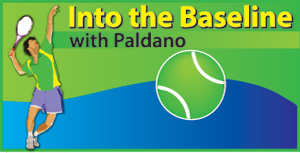Tennis tactics of today
View(s): Serving to ‘lethal’ returners
Serving to ‘lethal’ returners
For a server, the opponent’s weak return was considered the most advantageous to hit a winner. That is the way it used to be in Tennis. Today, it is not so anymore.
The ‘return of serve’ among the top two hundred players of the world has become very accurate, fast and extremely tactical, in short ‘lethal’. The ‘return of serve’ is now practiced by good players as a separate entity and some good players even have a coach only for this particular aspect. This is the reason behind most ‘second serves’ being mercilessly punished in the WTA and ATP tour. Currently, to win a service game comfortably, the most number of second serves allowed is as low as ‘one’ or at the most ‘two’ among ‘high rankers’. This means that maintaining a percentage of seventy plus with the ‘first serve’ is a tactical necessity. As we all know, when the speed increases, accuracy and high percentage of success is hindered.
Watching today’s Tennis, it seems as if there is no limit to the speed the game could reach. The world bodies are now struggling to find ways and means of slowing the game down to keep spectator interest high. The hard court which is a great convenience in maintenance, has accelerated speed and eliminated the variance in bounce which natural surfaces provide as an additional attraction, creating much exciting drama on court. Many venues are reverting to the sand and grass surfaces. It is a trend that could be considered ‘conservative’ in approach and the issues here are cost and labour.
Azerenka vs Mugurusa
The most exciting and interesting women’s match at the 2016 Miami-Open was by far, the one between Azarenka and Mugurusa in the round of 16 [U-tube carries it]. Azerenka, the eventual winner almost did not survive the match. What made the match so close (7/6, 7/6) was their ability to serve aces and return winners even during the most difficult score stand. I believe this is the only match of the tournament in which Azerenka lost her serve more than twice. Venezuela born Spaniard, Garbine Mugurusa matched Azerenka shot for shot in accuracy and speed in the return of serve. Both scored heavily with their returns. These two also played an all court game very effectively registering 80 percent success at net.
Former number one, Belarus born Azerenka returning to Tennis after a lapse of time always thrived in competition. She has shown great form and a new game this year. Azerenka sank below 50 in the ranking some time ago and now with three big titles already this year, has climbed up the ladder to 5 in the world and number one in the road to masters in Singapore. Right now, she is in ‘top gear’. Mugurusa too has trimmed herself and is showing determination to do well in 2016. In 2015 she ended at 4 in the ranking but yet to do anything impressive this year in terms of winning a title.
Nishikori vs Monfils
On the men’s side it was the quarter-final match between Japanese Kei Nishikori and France’s Gael Monfils that stole the show. Flamboyant Monfils played crowd appealing Tennis and had five match points in his favour. Nishikori showed that he is not in the top ten by mistake and neutralized the match-points against him and eventually won the match with the very first match-point playing effectively at net. Then Nishikori went on to beat Australian Nic Kyrgios in the semi final. Kyrgios is having a marvelous early season showing good form and has already accomplished his desire to get into the top 20 of the ranking this year.
In the finals Novak Djokovic beat Nishikori. Nishikori could not close in on the two-stroke advantage Djokovic has over him. Other matches in the round of 16 also saw relentless punishment of ‘second serves’. This has been developing for a while and now the return-of-serve in the world tour is as threatening as the ‘first-serve’.
Serving and returning ‘to glory’
Players now work for different goals. Players in the ranking between twenty and thirty are now targeting to better just 5 positions up the ladder, each time. For this they must consistently appear in the round of 16 and the quarter-finals. One way to do this is to avoid long tiring and grinding ground stroke duels whenever possible. Serving and returning ‘to glory’ is certainly a good tactical formula for it. It must be said that it is not the easiest or the safest one to indulge in. One has to have a high playing ability and physical resilience. Top thirty positions pay well in money to keep the head above the water in Tennis. With the modern trend of a player having a team does make the tour an expensive investment but the gain could be big if the player makes it to the top.
Two missing faces
Nadal and Federer are now frequently missing in the semi finals berth of events and sometimes in the draw. This is leaving Djokovic without a credible challenge. The next generation players if they want to reach the top ten, they will have to possess an all-court game with emphasis on the symbols of supremacy – ‘big serve’ and ‘punishing returns’. If any of our islanders want to walk with these ‘big guns’ they too better work out as to how to ‘serve’ with pin-point accuracy and speed even more importantly, ‘return serve’ with a lethal dose of accuracy and power.
George Paldano, Former int. player; Accredited Coach of Germany; National, Davis-Cup, Federation Cup coach–. georgepaldano@yahoo.com


